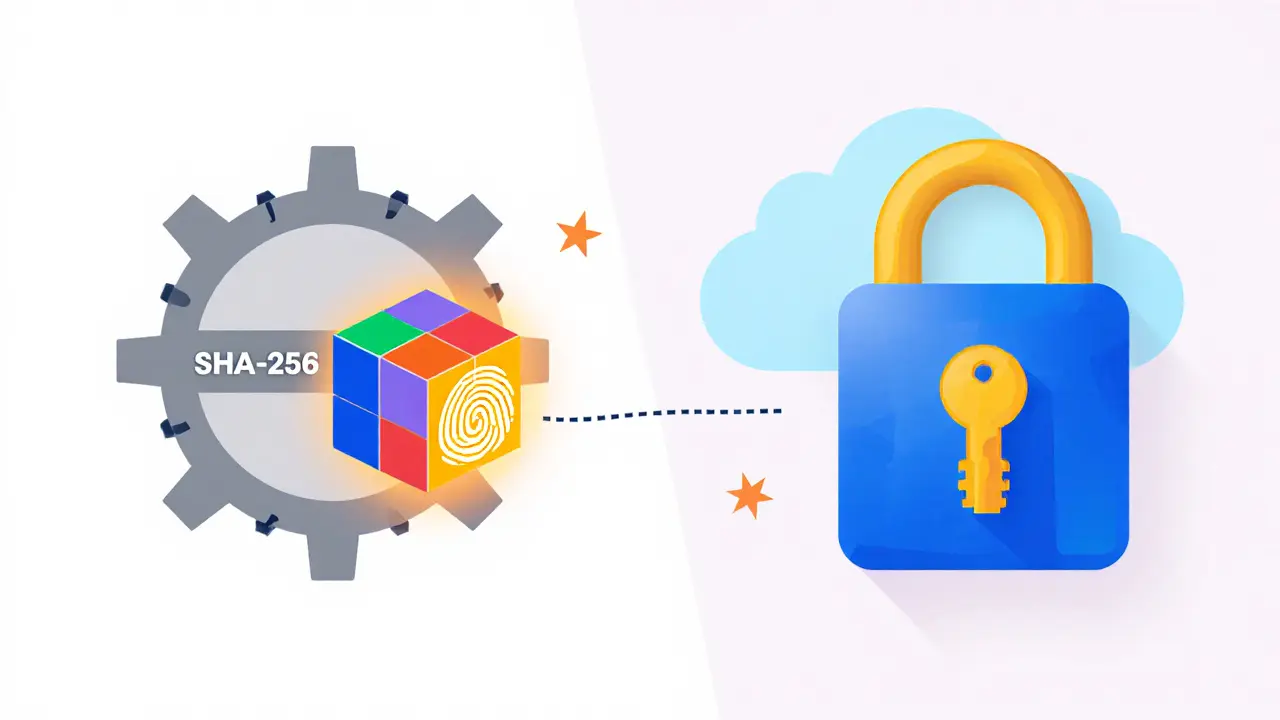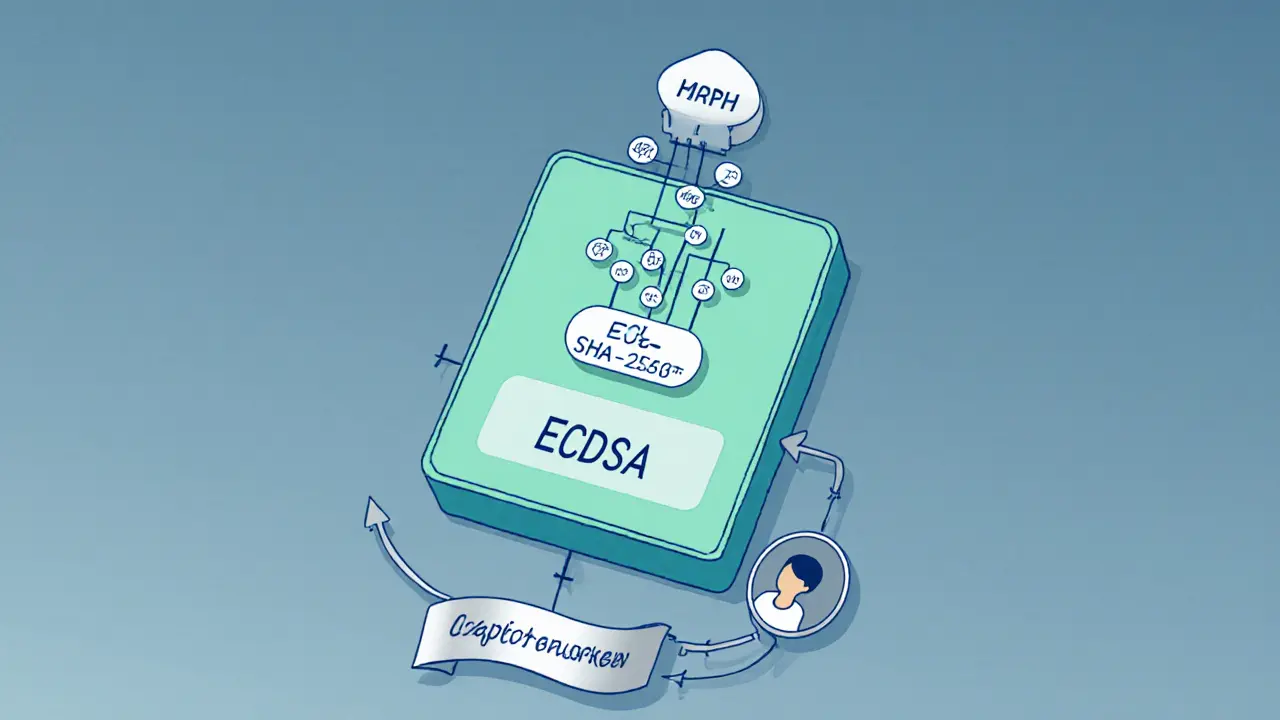Cryptographic Hashing vs Encryption in Blockchain: What Every Developer Should Know
 Oct, 31 2024
Oct, 31 2024
Blockchain Hashing Demonstrator
Enter text to calculate SHA-256 hash. See how changing a single character completely changes the hash due to the avalanche effect.
Hash Result
Avalanche Effect Demonstration
See how changing just one character creates a completely different hash:
When you read about blockchains, you’ll often hear the words "hashing" and "encryption" tossed around like they’re the same thing. In reality, they solve completely different problems, yet both are essential for the trustless world of distributed ledgers. This article pulls apart the two concepts, shows where each lives in a blockchain, and gives you practical pointers so you can decide which tool to reach for when you’re building or auditing a protocol.
Key Takeaways
- Hashing is a one‑way function that guarantees data integrity and links blocks together.
- Encryption is a two‑way process that protects confidentiality and authenticates participants.
- Blockchains use SHA‑256 (or its SHA‑3 successors) for hashing and ECDSA (or post‑quantum schemes) for encryption.
- Performance, key management, and future‑proofing differ sharply between the two.
- Choosing the right primitive depends on whether you need immutability, privacy, or both.
What Is Cryptographic Hashing?
Cryptographic Hashing is a deterministic, one‑way mathematical function that converts any input into a fixed‑length output, called a hash value. The most common hash in public blockchains is SHA‑256, which produces a 256‑bit (32‑byte) string regardless of whether you feed it a single word or an entire megabyte of data. Because the output length never changes, nodes can compare hashes instantly to verify that two pieces of data are identical.
Hashing brings three security properties to a ledger:
- Integrity: Any tiny change in the input results in a completely different hash (the avalanche effect).
- Uniqueness: Collisions-different inputs yielding the same hash-are astronomically unlikely; SHA‑256 offers about 2^128 collision resistance.
- Linkage: Each block stores the hash of its predecessor, forming an immutable chain.
Because hashing needs no secret key, it’s cheap to compute. Bitcoin miners, for example, perform roughly 250,000 SHA‑256 operations per block header every ten minutes.
What Is Encryption?
Encryption is a reversible transformation that turns readable data (plaintext) into unreadable ciphertext using a cryptographic key. In blockchains the dominant flavor is asymmetric encryption, where a public key encrypts or verifies data and a private key decrypts or signs it.
The classic scheme used by Bitcoin and Ethereum is the Elliptic Curve Digital Signature Algorithm (ECDSA), built on the secp256k1 curve. A user’s 256‑bit private key generates a 512‑bit public key (compressed to 264 bits for addresses). When you sign a transaction, your private key creates a digital signature that anyone can verify with the public key-proving ownership without revealing the private key itself.
Encryption provides two key security benefits:
- Confidentiality: Only the holder of the private key can decrypt or produce a valid signature.
- Authentication: Digital signatures confirm that a transaction really came from the claimed sender.
Because it involves expensive mathematical operations (point multiplication on the curve), a single ECDSA signature typically costs ~0.3 ms on modern CPUs-still fast enough for high‑throughput networks but noticeably slower than a hash.

How Both Primitives Fit Into a Blockchain
Picture a Bitcoin block. First, the miner gathers a list of transactions. Each transaction is signed with ECDSA, proving who can spend the inputs. Next, the miner builds a Merkle tree-hashing each transaction, then hashing pairs of hashes repeatedly until a single root hash emerges. That Merkle Tree root appears in the block header. Finally, the miner runs a proof‑of‑work loop, repeatedly hashing the block header (including the previous block’s hash) until the result meets the difficulty target.
In this flow:
- Encryption (ECDSA) secures who can move funds.
- Hashing (SHA‑256) secures the block’s structure, links it to history, and enables quick integrity checks.
Both are mandatory: remove hashing and the chain can be rewritten; remove encryption and anyone could spend anyone else’s coins.
Technical Comparison
| Aspect | Cryptographic Hashing | Encryption (Asymmetric) |
|---|---|---|
| Purpose | Data integrity & block linking | Confidentiality & authentication |
| Direction | One‑way (irreversible) | Two‑way (requires private key to reverse) |
| Typical Algorithm | SHA‑256, SHA3‑512 | ECDSA (secp256k1), CRYSTALS‑Dilithium (post‑quantum) |
| Output Size | Fixed (32 bytes for SHA‑256) | Variable (≈71 bytes signature, 264 bits address) |
| Performance (per operation) | ~280 MB/s throughput, < 0.01 ms per hash | ~0.3 ms per signature on a modern CPU |
| Key Management | None required | Private‑key generation, storage, rotation |
| Common Vulnerabilities | Collision attacks (theoretically feasible only with quantum computers) | Key leakage, side‑channel attacks, signature malleability |
| Use Cases in Blockchain | Block hashes, Merkle roots, transaction IDs, password storage | Transaction signing, wallet address generation, confidential transaction schemes |
Real‑World Implementations
Bitcoin relies on SHA‑256 for all hashing and ECDSA/secp256k1 for signatures. As of October 2025 the network processes ~300 k transactions daily, each secured by both primitives.
Ethereum uses Keccak‑256 (a SHA‑3 variant) for hashing and ECDSA for signatures. Its Merkle‑Patricia trie structure leans heavily on hash functions to enable fast state proofs.
Monero demonstrates where encryption takes the spotlight. It adds RingCT (Ring Confidential Transactions) that hide amounts using elliptic‑curve cryptography, while still using hashes for block linking.
Newer chains like Algorand are already experimenting with post‑quantum resistant signatures such as CRYSTALS‑Dilithium, showing the industry’s shift toward future‑proof encryption.

Challenges and Future Directions
Even the strongest current hash, SHA‑256, faces a long‑term threat from quantum computers. Researchers estimate that a sufficiently large quantum machine could mount a pre‑image attack within 7‑10 years, prompting a gradual migration toward SHA‑3 family algorithms (Keccak‑256, SHA3‑512). Meanwhile, the NIST Post‑Quantum Cryptography standard (finalized 2024) encourages blockchains to adopt lattice‑based signatures to protect against quantum key recovery.
Encryption’s biggest practical hurdle remains key management. A single compromised private key can empty a wallet-evidence includes the 2022 Wormhole hack that stole $320 M after a key leak. Best practices involve hardware wallets, multi‑sig schemes, and regular key rotation.
From a performance standpoint, hashing remains faster than any asymmetric operation, a fact confirmed by DuoCircle’s 2023 benchmarks showing hashing 3.7× quicker than comparable encryption workloads on typical node hardware.
Developers should also watch emerging standards like SPHINCS+, a stateless hash‑based signature scheme that could replace ECDSA in future permissionless networks.
Practical Guidance for Developers
If you’re building a new blockchain or a smart‑contract platform, ask yourself these questions:
- Do I need confidentiality? If the use case involves private data (health records, KYC info), invest in strong asymmetric encryption and consider zero‑knowledge proofs.
- Is speed critical? For high‑throughput public ledgers, rely on fast hash functions for block headers and Merkle proofs; keep encryption limited to signature verification.
- What’s the key‑management strategy? Use hardware security modules (HSMs) or secure enclaves for private keys, and enforce multi‑signature policies for high‑value accounts.
- Am I future‑proofing? Choose algorithms with a clear migration path to post‑quantum alternatives (e.g., start with SHA‑3 now, design your protocol to swap in CRYSTALS‑Dilithium later).
- Do I need to verify integrity locally? Implement SHA‑256 verification libraries (OpenSSL, libsodium) that have been audited and are widely supported.
Following these steps reduces the risk of costly rewrites and keeps your network compliant with emerging regulations like the EU’s MiCA, which mandates strong hash integrity checks for data storage.
Frequently Asked Questions
What’s the main difference between hashing and encryption?
Hashing turns data into a fixed‑size, irreversible fingerprint; encryption scrambles data so it can be restored with a key. Hashing proves integrity, encryption protects confidentiality and authenticates parties.
Why does Bitcoin use SHA‑256 instead of a newer hash?
When Satoshi wrote the whitepaper (2008), SHA‑256 was the best‑studied, widely‑available hash with strong collision resistance. Its simplicity also made hardware acceleration easy, which is still valuable for proof‑of‑work mining.
Can I replace ECDSA with a post‑quantum signature today?
Some test‑nets already experiment with CRYSTALS‑Dilithium or Falcon, but mainstream public chains have not migrated yet because the new schemes need larger signatures and broader tool support. You can run a hybrid mode in a private network.
Is hashing ever used for password storage on blockchain platforms?
Yes. Many dApps store user passwords off‑chain after hashing them with bcrypt or Argon2, then keep only the hash on the blockchain. The irreversibility of hashing prevents the original password from ever being leaked.
How does quantum computing affect hash functions?
Quantum algorithms (like Grover’s) can halve the effective security level of a hash. This means SHA‑256’s 128‑bit collision resistance would drop to about 64 bits, prompting a move to SHA‑3 or hash‑based post‑quantum schemes.
Prateek Kumar Mondal
October 25, 2025 AT 04:08Hashing for integrity encryption for ownership simple as that
Jasmine Neo
October 26, 2025 AT 02:31Wow another crypto bro pretending he understands math. SHA-256? ECDSA? Please. The whole thing is just a glorified spreadsheet with extra steps. And don't even get me started on how these 'decentralized' systems are all hosted on AWS anyway. Americans think they're so smart with their blockchain buzzwords. 🤡
William P. Barrett
October 26, 2025 AT 10:07What's interesting is how hashing creates trust without authority. You don't need to believe in a central validator - you just need to believe in math. The chain isn't secure because someone said so, it's secure because flipping a single bit in a transaction makes the entire chain look like garbage. It's like a Rube Goldberg machine made of cryptographic principles. And encryption? That's the gatekeeper. It doesn't tell you what happened - it tells you who did it. Two sides of the same coin: one for truth, one for identity.
Most devs treat them like interchangeable tools because they're both 'crypto' in the name. But one is a fingerprint scanner, the other is a locked diary. You wouldn't use a fingerprint to keep secrets - and you wouldn't use a diary to prove a document hasn't been altered.
The real genius is how Bitcoin layers them: hashing for structure, encryption for agency. One builds the skeleton, the other gives it a voice. Remove one and the whole thing collapses into either a forgery or a free-for-all.
Cory Munoz
October 27, 2025 AT 02:04Thanks for breaking this down clearly. I’ve been confused for years why people mix these up. It’s like saying 'firewall' and 'antivirus' are the same because they both protect your computer. They’re not. One checks if something changed, the other checks if you’re allowed to do it. Small difference, huge consequences.
Also appreciate the mention of key management. So many people lose their coins not because the tech broke - but because they saved their private key in a Notes app named 'my crypto lol'. 😅
Nick Cooney
October 27, 2025 AT 20:39lol i just read this whole thing and now i feel like i need a degree in math to use a wallet. also 'post-quantum' sounds like a band name for a bunch of crypto bros who think they're sci-fi authors. but hey, at least we're not using MD5 anymore. progress? maybe. also typo in 'secp256k1' - you wrote 'secp256k1' twice but one time it was 'secp256k1' with a weird space. i'm not mad just disappointed.
Clarice Coelho Marlière Arruda
October 28, 2025 AT 02:55so hashing is like putting your essay through a blender and getting back a weird smoothie code. if someone changes a word, the smoothie tastes totally different. encryption is like locking your diary with a key only you have. you can read it later, but no one else can. kinda makes sense now? also i think i spelled 'encryption' wrong in my notes lol
Ron Murphy
October 28, 2025 AT 14:26SHA-256 is still king, but the post-quantum shift is inevitable. Dilithium signatures are bulky - 4KB vs 71 bytes for ECDSA - but if quantum computers crack ECDSA, size doesn't matter. What's wild is that hashing is already more quantum-resistant than we think. Grover’s algorithm only gives a square root speedup, so SHA-256's 128-bit security becomes 64-bit - still way above brute-force feasibility for decades. The real threat is to asymmetric crypto. Hash-based signatures like SPHINCS+ might be the quiet winners here.
Brian Collett
October 29, 2025 AT 00:09Bro I just built a dApp and used SHA-256 for transaction IDs and ECDSA for signing. I didn’t even think about the difference until now. Now I feel like I’ve been driving a car without knowing how the engine works. Also why does everyone keep saying 'Merkle tree' like it's a coffee shop? I had to google it again. But honestly, this post saved me from a future audit nightmare. Thanks.
Jean Manel
October 29, 2025 AT 03:07Let me just say this - if you're using ECDSA in 2025 and haven't considered signature malleability, you're one exploit away from being a meme. And don't even get me started on how Bitcoin's lack of upgradeability makes this entire discussion a time capsule. SHA-256? ECDSA? Please. We're still running on 2009 tech because 'it works'. Meanwhile, real systems use zk-SNARKs and threshold signatures. This article is like explaining how to use a rotary phone while everyone else has 5G.
Allison Andrews
October 29, 2025 AT 07:32It's fascinating how the same mathematical tools serve such different philosophical purposes. Hashing is about truth - immutable, objective, independent of identity. Encryption is about personhood - ownership, agency, the right to be unseen. One binds the chain to reality, the other protects the individual within it. Blockchains don’t just store data - they encode a political idea: that trust can be distributed, and identity can be sovereign. We call it crypto, but really, it’s digital existentialism.